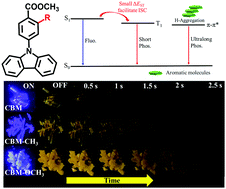Designing organic room temperature phosphorescence with ultralong lifetime by substituent modification†
Abstract
Organic room temperature phosphorescent (RTP) materials have potential applications in the fields of bioimaging, anti-counterfeiting, and displays. However, developing organic RTP materials with ultralong lifetime are still difficult due to inefficient intersystem crossing (ISC) and rapid non-radiative decay rate of the triplet state. Here, we design three carbazole-based compounds (CBM, CBM-CH3 and CBM-OCH3) and reveal underlying the mechanism of their variable RTP lifetime. Three carbazole-based crystals exhibit ultralong lifetime RTP from 123.2 ms to 601.5 ms and then to 929.2 ms. Combined with single crystal analysis and theoretical calculation, a small energy gap (ΔEST) between the lowest singlet (S1) and triplet (T1) states efficiently promotes ISC. Moreover, a pure π–π* configuration of T1 ensures a slow phosphorescent decay rate, resulting in an ultralong lifetime RTP. In particular, CBM-OCH3 adopts an H-aggregation packing structure to stabilize triplet excitons, leading to the longest RTP lifetime of those reported here (929.2 ms). Furthermore, three carbazole-based compounds with variable RTP lifetime are utilized for anti-counterfeiting applications. Our study provides a new insight into the design of organic RTP materials with ultralong lifetime and realizes its application in the field of information storage.

- This article is part of the themed collection: Journal of Materials Chemistry C HOT Papers


 Please wait while we load your content...
Please wait while we load your content...